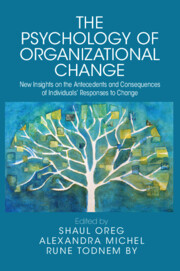 The Psychology of Organizational Change
The Psychology of Organizational Change Book contents
- The Psychology of Organizational Change
- The Psychology of Organizational Change
- Copyright page
- Contents
- Contributors
- Part I Introduction
- Part II The Evolution of Change and Its Responses
- Part III Change in Context
- Chapter 5 Exploring Types of Organizational Change and Differential Effects on Employee Well-Being and Personal Development
- Chapter 6 Employee Responses to Technological Change
- Chapter 7 Identification Change in Chinese Acquisitions in Europe
- Chapter 8 Social Identity Processes in Sino-Western Mergers and Acquisitions
- Part IV The Development of Change Leadership
- Part V The Process of Change Leadership
- Part VI Conclusions and Commentary
- Index
- References
Chapter 5 - Exploring Types of Organizational Change and Differential Effects on Employee Well-Being and Personal Development
from Part III - Change in Context
Published online by Cambridge University Press: 28 September 2023
- The Psychology of Organizational Change
- The Psychology of Organizational Change
- Copyright page
- Contents
- Contributors
- Part I Introduction
- Part II The Evolution of Change and Its Responses
- Part III Change in Context
- Chapter 5 Exploring Types of Organizational Change and Differential Effects on Employee Well-Being and Personal Development
- Chapter 6 Employee Responses to Technological Change
- Chapter 7 Identification Change in Chinese Acquisitions in Europe
- Chapter 8 Social Identity Processes in Sino-Western Mergers and Acquisitions
- Part IV The Development of Change Leadership
- Part V The Process of Change Leadership
- Part VI Conclusions and Commentary
- Index
- References
Summary
Past decades have shown an increase in research into employee responses to organizational change (OC). However, little attention has been paid to the impact of the type of change. Different types of change are likely to affect change recipients’ learning and well-being in a different way. Our study aimed to identify OC types and investigate whether these are differentially associated with employee responses. Exploring OC types, two dimensions were distinguished and combined: a qualitative axis representing the prevalence of innovation; and a quantitative axis distinguishing between growth and decline. In a representative sample of private sector employees from a longitudinal survey, cluster analyses identified six OC types. We investigated whether these OC types are differentially associated with active workplace learning and emotional exhaustion. Results indicated that active learning is stimulated by OC types characterized by innovation/growth, while OC types characterized by decline and restructuring without innovation are associated with higher emotional exhaustion. In conclusion, various OC types revealed differential effects on employee personal development and well-being.
Keywords
- Type
- Chapter
- Information
- The Psychology of Organizational ChangeNew Insights on the Antecedents and Consequences of Individuals' Responses to Change, pp. 95 - 119Publisher: Cambridge University PressPrint publication year: 2023


